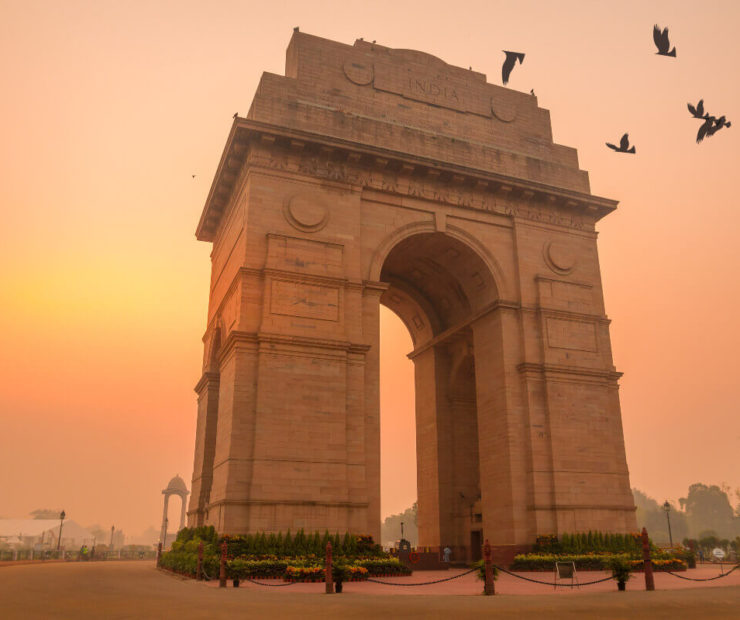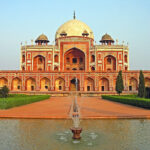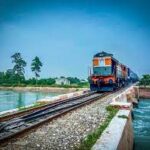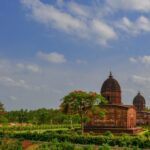
India Travel Guide
India Travel Guide – Everything you need to know
India is a vast nation renowned for its vibrant cities, varied landscape, and rich cultural heritage. Whether you’re interested in exploring the historical monuments, experiencing the vibrant culture, or simply soaking in the natural beauty, India has something for everyone. Here is a comprehensive travel guide to help you plan your trip to India.
The tourism industry in India has shown phenomenal growth over the past decade. One of the causes is the fact that India’s Ministry of Tourism has come to understand the enormous potential of tourism there during the holidays.
Travel tourism in India has rapidly expanded as a result of the massive influx of visitors from all over the world who have been drawn to the country by its incredible natural beauty and rich cultural heritage.
Every traveler’s heart is captured by India’s tourism, with its misty hill stations, alluring beaches, historical monuments, golden deserts, peaceful backwaters, pilgrimage sites, abundant wildlife, and vibrant fairs. Your trip to India as a tourist will also be truly fantastic and unforgettable thanks to the country’s numerous festivals, busy markets, vibrant way of life, and traditional Indian hospitality.
Travel through the enchanting states of India and get up close and personal with the dazzling colors and rich cultural sights of this amazing land.
Visa Requirements: Most foreign nationals need a visa to enter India. You can apply for an e-Visa online, which is valid for 60 days and can be used for tourism, business, and medical purposes. You can also apply for a regular visa at the Indian embassy or consulate in your country.
When to visit: India is a vast country with a range of climates. The best time to visit depends on where you plan to go. Generally, the winter months from October to March are the most comfortable for travel. However, if you’re planning to visit the hill stations in the north th, the summer months from April to June are ideal.
Getting around: India has an extensive network of buses, trains, and flights that connect various parts of the country. You can also hire a car with a driver, which is a convenient and safe option for traveling long distances. Taxis and auto-rickshaws are also readily available in cities.
Accommodation: India offers a range of accommodation options, from budget guesthouses to luxury hotels. You can also experience the local culture by staying in homestays or guesthouses run by local families. Booking.com, Agoda, and Airbnb are popular platforms to fbookingand book accommodation.
Food: Indian cuisine is famous for its spices and flavors. From street food to fine dining, you’ll find a range of options to satisfy your taste buds. Popular dishes include butter chicken, biryani, dosa, and samosas. Vegetarian food is also widely available and popular in India.
Culture and etiquette: India is a diverse country with many cultures and religions. It’s important to respect local customs and etiquette. Dress modestly, particularly in religious places. Remove shoes before entering a temple or mosque. Avoid public displays of affection. Ask permission before taking photos of people.
Places to visit
India has a range of attractions to explore. Here are some of the top places to visit:
Taj Mahal: The Taj Mahal is a marble wonder. One of the most famous tourist destinations in India is the enormous mausoleum, which is situated in the city of Agra on the southern bank of the Yamuna River. The majestic structure took 17 years to complete and was built by Emperor Shah Jahan in memory of his favorite wife, Mumtaz Mahal. Plan and arrive at dawn, as the light of the rising sun gives the building an ethereal glow, and avoids the crowds, giving you time to view the Taj Mahal in relative peace.
Agra Fort: The lavish fort made of red sandstone that is situated along the Yamuna River’s banks must be seen by visitors to Agra. The fort, which was built in 1565, is home to a maze of buildings, including vast dungeons, and was originally built as a military structure before being converted to a palace, then a gilded prison. Agra Fort has a fascinating history that is worth exploring.
Delhi Red Fort: Delhi’s Red Fort gets its name from its massive red sandstone walls, built-in 1638 to keep out invaders. Lahore Gate, the main entrance, is a focal point for contemporary India and attracts sizable crowds on Independence Day. Home to the Mughal dynasty emperors for nearly 200 years before the British took over, it is now one of Delhi’s most popular tourist attractions.
Hawa Mahal (Pink Palace): The 18th-century Hawa Mahal in Jaipur, also known as the ‘Palace of the Breeze’, features an intricate lacy façade carved from pink sandstone, designed for ladies of the royal court to discreetly observe the underlying street scenes without being seen by others. the public. The five-story building has 953 panes of glass that allow a gentle breeze to flow through it. Good tip: the impressive palace is best viewed from the rooftop cafes across the street.
Amber Fort: A magnificent example of Hindu and Mughal-style architecture can be found in Amber (pronounce “Amer”), which is about 11 kilometers from Jaipur. Built of red sandstone and marble, the opulent palace is divided into four main sections, each with its courtyard. The magnificent Maota Lake view from the Amber Fort only serves to emphasize the palace’s magnificence.
Monkey Temple: Galtaji is also known as the Monkey Temple after the large colony of monkeys that inhabit the temple, on the outskirts of Jaipur. This unique Hindu temple is located around natural springs where visitors come to bathe in the holy waters and atone for their sins. It is nestled among low hills.
Jantar Mantar: In the early 1700s, Jai Singh built the Jantar Mantar astronomical observatory in New Delhi. It is a UNESCO World Heritage Site. Employ a guide to describe the equipment astrologers use to see the positions of the stars in plain sight. Don’t miss the world’s largest sundial made entirely of stone.
Where to eat in India
India is a culinary paradise and an eye-pleasing feast for the senses. Each region of India offers distinctive food that reflects its regional and cultural heritage. Religion is a major factor in many dietary decisions in India, where a large portion of the population does not eat meat, and where some of the world’s heartiest and most delectable vegetarian dishes are produced. The distinctions between North Indian and South Indian cuisine show the country’s diverse culinary heritage.
Street Food in India: Indian street food is as diverse as Indian cuisine. Some of the most popular street food dishes are kebabs, pakoras, tandoori chicken, vada pav, and samosas. Australian celebrity chef Christine Mansfield was inspired to write Tasting India, a travelogue and cookbook. Mansfield says there are excellent kebabs in Delhi and Mumbai, especially Bade Miya in Mumbai.
Indian Restaurants: There is no shortage of restaurants in India to enjoy the local cuisine. In the year 1135 AD, an opulent dining room fit for a royal feast of Rajasthani flavors is an absolute necessity in the magnificent setting of Amber Fort. In Mumbai, a famous place loved by the locals is Girgaum Chowpatty. Another icon of the city is Shree Thaker Bhojanalay, a restaurant popular with the locals that serves the best Gujarati thali in the city.
Where To stay in India
Hotels
There is a wide range of accommodations available in India, from hotels, guest houses, boutique hotels, and budget hotels, to suit every traveler’s needs. Maharajas, dignitaries, and celebrities have stayed at the renowned Taj Mahal Palace Hotel for decades because of its grace, charm, and luxury.
Luxury Accommodation
The height of luxury is to stay in a haveli villa, a medieval fort, or even a royal palace with jeweled walls and expansive dining halls, and India offers this kind of experience everywhere.
Floating on the waters of Lake Pichola, in the legendary Indian region of Udaipur, the Taj Lake Palace is considered one of the most luxurious and romantic hotels in the world.
The best places to visit in India
Delhi: The capital city of India, known for its historical monuments and bustling markets. The natural starting point for most visitors is the capital city of India, Delhi. It is also the first port of call for travelers taking the route through India’s famous Golden Triangle. Delhi provides an intriguing contrast between the ancient and the modern with its numerous historical sites, bustling markets, and other attractions. The top things to see and do in Delhi include the World Heritage-listed Red Fort and Jama Masjid, one of the largest mosques in Southeast Asia. Delhi is a must-visit location because of its wide range of cultural influences, a profusion of vegetation, opulent imperial architecture, and intriguing cuisine.
Agra: Home to the Taj Mahal, one of the Seven Wonders of the World.
Agra is an ancient city on the banks of the Yamuna River, home to one of the seven wonders of the world, the Taj Mahal. But the Taj is not an attraction in itself, as Agra also displays spectacular Mughal architecture around every corner and plenty of important archaeological sites to discover.
Jaipur: Known for its forts, palaces, and colorful culture. With Rajasthan known as the “Land of Kings,” it stands to reason that its capital is the country’s showpiece: grand palaces, glamorous hotels, pink architecture, and everything in between. Marvel at the Palace of Winds, be a spectator of the ‘sport of kings’, or go on a leopard safari, there is so much to see and do in Jaipur.
Mumbai: The financial capital of India, known for its Bollywood film industry and street food. From the flashy to the gritty, from the historic to the heartbreaking, Mumbai is a city of contrasts. Mumbai is the home of Bollywood, and there are a handful of tours that let you into the vast Movie City that is otherwise inaccessible to the public. It is also a city with strong historical ties, magnificent British architecture, and places of worship. Formerly known as Mumbai, modern Mumbai has evolved into India’s commercial and entertainment hub.
Goa: Famous for its beaches, nightlife, and colonial architecture. Nestled between the related giant states of Maharashtra to the north and Karnataka to the south and east is the tiny Indian state of Goa, which is incredibly relaxed and utterly charming. Goa’s picture-perfect coastlines and beaches, stunning architecture, trendy dining options, and mouthwatering cuisine make it a popular vacation destination all year long.
Kerala: Known as “God’s Own Country” for its natural beauty, backwaters, and beaches. Kerala, a state in southern India known for its palm-lined beaches and network of canals, is a popular tourist destination. Traveling by boat, especially on houseboats through canals and waterways, is an essential experience for anyone who needs a break from everyday life. Kerala by boat may be the most amazing thing you have ever done…
Luxury travel in India
There are numerous tour options to make your tailor-made holiday in India unforgettable, or if you prefer a fully escorted tour of India, book with a reputable company like Scenic Tours, which will ensure that your every need is met. If you choose a tour guide, you’ll benefit from a carefully thought-out schedule and an all-inclusive package price to ensure peace of mind.
Safety: India is generally safe for tourists, but it’s important to take precautions. Keep your valuables safe and avoid walking alone at night, particularly in deserted areas. Be cautious of scams and touts. Avoid drinking tap water and eat at hygienic places.
Money: The official currency of India is the Indian rupee (INR). You can exchange your currency at banks or exchange bureaus, or withdraw cash from ATMs. Credit cards are widely accepted in cities, but it’s advisable to carry some cash for small purchases or when traveling to rural areas.
Language: Hindi and English are the official languages of India, but there are many other regional languages spoken throughout the country. In major cities and tourist areas, you’ll find that many people speak English, but it’s always helpful to learn a few basic phrases in Hindi or the local language.
Health: It’s advisable to get vaccinations before traveling to India, including for hepatitis A and B, typhoid, and tetanus. Mosquito-borne illnesses such as dengue fever and malaria are common in some parts of India, so it’s important to take precautions such as wearing insect repellent and covering up with long-sleeved clothing. Avoid drinking tap water and stick to bottled water or purified water.
Etiquette: In addition to respecting local customs, there are a few other things to keep in mind when traveling in India. Don’t use your left hand for eating or handing things to others, as it’s considered impolite. Remove your shoes before entering someone’s home or a place of worship. Don’t point your feet at someone, as it’s considered disrespectful. Be patient and expect delays, as things often move at a slower pace in India.
Shopping: India is famous for its handicrafts, textiles, and spices, among other things. You can find a range of souvenirs at markets and bazaars, but be prepared to haggle for a good price. It’s also worth checking out government-run emporiums, which offer fixed prices and authentic products.
Technology: India uses a 220-240 volt electrical system with Type C, D, and M plugs. If you’re traveling from a country with a different system, you’ll need a voltage converter and plug adapter. You can buy a local SIM card for your phone, which will give you access to 4G data and make it easier to stay connected while traveling.
Festivals: India is known for its colorful festivals, which are a great way to experience local culture. Some of the most popular festivals include Diwali (festival of lights), Holi (festival of colors), and Durga Puja (celebration of the goddess Durga). Check the dates of festivals before planning your trip, as they can impact travel and accommodation availability.
Environmental concerns: India is a country with a rapidly growing population and a significant environmental impact. As a traveler, you can help minimize your impact by avoiding single-use plastics, conserving water and electricity, and being mindful of your waste. Consider using eco-friendly products and supporting sustainable tourism initiatives.
Transportation: India has a variety of transportation options, including buses, trains, taxis, and auto-rickshaws. Public transportation can be crowded and hectic, so it’s often easier to hire a private driver or take a taxi or auto-rickshaw for shorter trips. If you’re taking a long-distance train, book your tickets in advance as they can sell out quickly.
Safety: India is generally a safe country to travel in, but it’s important to take precautions to avoid theft and scams. Keep your valuables close and be aware of your surroundings, especially in crowded areas. Be wary of strangers offering unsolicited help or advice, as they may be trying to scam you.
Culture: India has a rich cultural heritage, and it’s important to respect local customs and traditions. Dress modestly, especially when visiting religious sites or rural areas. Take your shoes off before entering someone’s home or a place of worship. Ask permission before taking photos of people or religious sites.
Weather: India has a diverse climate, with hot summers and cool winters in the north, and a tropical climate in the south. The monsoon season lats from June to September, and can bring heavy rains and flooding to some areas. Check the weather before traveling and pack accordingly.
Sightseeing: India has many popular tourist attractions, including the Taj Mahal, the Golden Temple, and the beaches of Goa. It’s a good idea to book tickets and tours in advance to avoid long lines and crowds. Consider hiring a local guide to learn more about the history and culture of the places you’re visiting.
Conclusion
India is a vibrant country with a rich history and culture. With the right planning and precautions, it’s a great destination for travel. Remember to respect local customs and etiquette, stay safe, and enjoy your trip to India.
Recent Posts
List Of Best Vacation Spots In Delhi
Kovalam To Munnar: A Must-Do For An Incredible Experience!
Bishnupur Tourism: Visit Bishnupur for some Cultural fun!
Tags

Thailand





